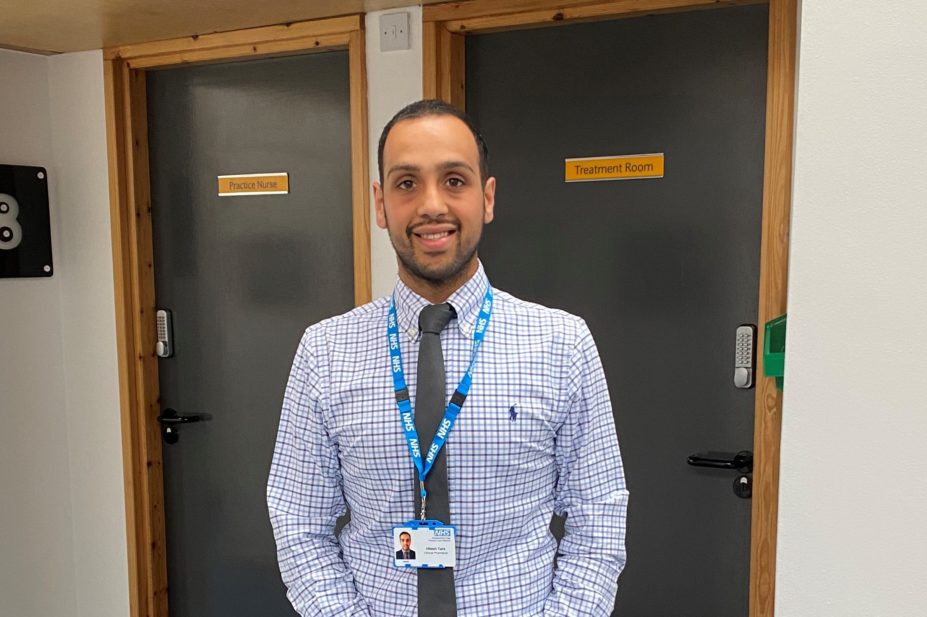
Hitesh Tara
In 2019, I began working at South Warwickshire East Primary Care Network (PCN) as its first clinical pharmacist. I made this switch to primary care after seven years in community pharmacy.
My role is a mix of both clinical and non-clinical duties, which include reviewing patients and their medicines, as well as actively taking part in quality improvement initiatives. I work closely with GPs, pharmacists and nurses, as well as administration staff, who, among other duties, manage communication with my patients post-consultation. Social prescribers are also core members of the team and I often refer patients, who may be struggling emotionally, to them.
08:45 — start
Today I am based at Southam GP practice. As I arrive at work, I make a point of spending a few minutes catching up with colleagues. I work across four general practices, so this helps members of the team know when I am physically on site should they have any queries for me during the day. I also found it made integrating into the team much easier when I first started.
Email is my main form of communication with surgeries in my network, so I spend the next half an hour sorting through correspondence and replying to queries.
09:30
I check the practice clinical system for any patient-specific tasks actioned to me by colleagues.
Today, a GP is requesting a medication review for a patient with swallowing difficulties who uses a dosette box to organise all their medicines. As their dosette is due this week, any medicines changes I suggest from solid to liquid will be high priority.
I consult with the patient’s wife — who has been given authority to discuss her husband’s medicines — over the phone and review each of the seven tablets prescribed. I find that only the mirtazapine prescribed for mood and sleep is causing the patient difficulties with swallowing because of the size of the tablet. Using my past community pharmacy experience, I identify the correct tablet and, as I am based at a surgery with a small dispensary, I confirm this with the same brand and strength of mirtazapine tablets in the dispensary’s stock.
The PCN is currently in the process of obtaining a subscription for the NEWT Guidelines, which provide guidance on administration of medicines to patients with enteral feeding tubes or swallowing difficulties, so I refer to the most up-to-date guidance used by the trust on crushing preparations. I then develop a care plan for the patient in the event any of their other medicines become troublesome in the near future.
I log my recommendations into the surgery’s clinical system to communicate my suggested plan to the multidisciplinary team.
11:00
During the current coronavirus pandemic, we have been focusing on minimising the risk of exposure for shielding patients who are still at high risk of contracting COVID-19. As part of this, I have been reviewing patients with atrial fibrillation on warfarin and assessing their suitability for a switch to a direct oral anticoagulant (DOAC) using a template I developed. This includes a list of questions prompting clinicians to gather the required information for a safe and appropriate switch. Starting a DOAC eliminates the need for shielding patients to attend face-to-face appointments required to monitor their international normalised ratio.
Today I come across an interesting case where a patient has been advised by their cardiologist to stay on warfarin due to a clinically significant interaction between verapamil and DOACs. After some research I discover this interaction varies between different DOACs, and that rivaroxaban has little to no interaction with verapamil. After consulting with my clinical supervisor, a GP at the practice, we agree that I should write to the responsible cardiologist in secondary care, summarise my findings, and ask for their specialist opinion.
12:30
Part of my PCN role requires completion of the primary care pharmacy education pathway, and to have a GP as my nominated clinical supervisor to oversee my progression. This is in place to support pharmacists in developing the skills and knowledge required to work in primary care.
Having a good relationship with my clinical supervisor is important, as they are the first point of contact for any clinical concerns and act as an assessor for the clinical competencies. We usually have regular contact via email, but today we sit down together for half an hour to reflect on the previous two weeks and agree a development plan for the two weeks ahead. This includes reviewing patients with more complex medical conditions.
In general practice the GPs will typically be busy morning and afternoon; therefore this is the perfect time to catch up.
13:00
I attend our weekly team meeting. This is an opportunity for pharmacists within the PCN to share ideas and address any issues.
Today we are planning our next protected learning time sessions and decide on a range of topics we feel we can benefit from. These are designated learning sessions for all GP staff and, as clinical pharmacists, we have sessions for disease states and topical issues. With the growing network of PCN pharmacists, it is important for teams to build the required level of knowledge to practice safely and effectively, which also includes non-clinical topics, such as IT training.
14:00
I manage all Medicines and Healthcare products Regulatory Agency (MHRA) drug alerts for several of the surgeries. Today there is a recall for a particular brand of adrenaline 500 microgram auto-injectors due to an issue with activation of the device.
I phone all patients affected and offer an appropriate substitute, ensuring I provide the appropriate dosage instructions based on patient age and weight.
To make the switch smoother, I order some patient packs and placebo pens for the dispensary staff to distribute and demonstrate appropriate technique to patients. Because of the number of patients identified, this required additional time and planning.
15:30
Over the past few months I have built a good working relationship with one of the GP registrars. They ask my opinion about appropriate dyspepsia treatment for a patient on methotrexate if H2 receptor antagonists are unable to be dispensed by the patient’s community pharmacy owing to medicines shortages. The patient mentioned to the registrar that their information leaflet for omeprazole advises against concomitant administration with methotrexate — an interaction the registrar could not find.
Several resources, including the
British National Formulary
and Stockley’s Drug Interactions, report a severe interaction between proton pump inhibitors and methotrexate. I advise the registrar to withhold omeprazole and use an alginate when required with review of the patient’s symptoms in one week, and continue this therapy until an H2 antagonist is available.
16:00
A GP has referred an elderly patient to me after a recent diagnosis of atrial fibrillation requiring anticoagulation. I was asked to contact the patient and develop a plan for treatment initiation and counselling.
A recent blood test shows the patient’s glomerular filtration rate to be within reference range but given her age, creatinine clearance is a more accurate reflection of renal function. To avoid unnecessary risk of exposure to coronavirus, I ring the patient and ask her to weigh herself, which she is happy to do. Based on her weight and age, I calculate her creatinine clearance and determine a slight decline in renal function. For this reason, I recommend apixaban because of its low renal clearance and twice-daily administration to fit in with the patient’s current medicines regime. After contacting the pharmacy for delivery, I make a note to counsel the patient on its use and schedule a follow-up call in three months for appropriate monitoring.
19:00
My day usually finishes at 17:00, but, once at home, I make sure to set aside a few hours to study.
I am only 6 months into the 18-month primary care education pathway, but already I find it has been extremely useful for filling any gaps in knowledge. Being the first pharmacist for my PCN, I hope to develop both clinically and within the team, so I can eventually be in a position to provide much-needed support and guidance to the next cohort of primary care pharmacists.
Are you interested in a similar role?
- Networking is vital, and there are many platforms to help you do this. I found LinkedIn a great way to reach out to clinical pharmacists in general practice for advice and support;
- Register for NHS jobs and take the time to read the job descriptions of roles you are interested in. Prepare some real-life examples of how you meet the job requirements for use in your application and during the interview;
- Consider making yourself a five-year plan; this can help you see where you want to be and how you plan to get there;
- Undertake pharmacy postgraduate education to advance your clinical knowledge and evidence appraisal skills, but be sure you have the flexibility to study and complete your assessments on time. I currently study clinical pharmacy at De Montfort University.


